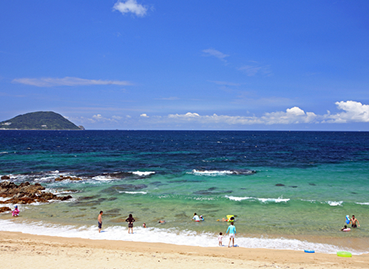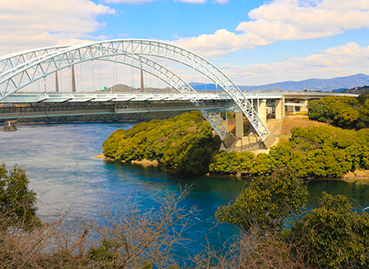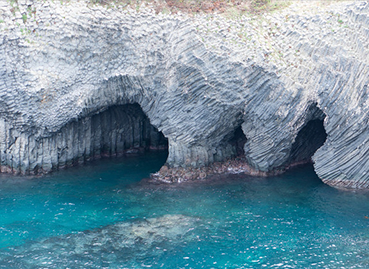
Visiting the Dazaifu-Tenmangu Shrine, famous viewing spots for autumn leaves, and getting in touch with Japanese culture. Drive route to enjoy the sunset by the sea of Nagasaki and its night view

Kamado Shrine
Kamado Shrine is a shrine (lower shrine) at the base of Mt. Homan-zan, and it is dedicated to the God of Marriage. This shrine has been a place of religious training for priests, and there is also another shrine (upper shrine) at the top of the mountain. A shrine surrounded by nature’s beauty and autumn colors is exceptionally beautiful. A lot of climbers as well as worshippers visit this place.
![]() 55 396 159
55 396 159

![]() About 12 minutes in the general road
About 12 minutes in the general road
![]() Distance of about 3.0km
Distance of about 3.0km

Komyozenji Temple
Komyozenji Temple, built in the Kamakura Period, is a spot with a splendid garden view commonly known as the kokedera (Moss Temple). In the backyard is Ittekikaiteinoniwa (one-drop-sea-garden) where the moss represents the land and white sand represents the ocean. In the front yard is Fukkosekitei, the only karesansui (dry landscape) garden in Kyushu where stones are beautifully set out. In the season of autumnal tints, fallen leaves beautifully spread out over the white sand, and you can enjoy the charming scenery. The autumn leaves are at their best from mid to late of November.
![]() 55 334 881
55 334 881

![]() About a 5-minute walk
About a 5-minute walk
![]() Distance of about 400m
Distance of about 400m

Dazaifu-Tenmangu
Walk under a Torii (an archway) of Dazaifu-Tenmangu Shrine and proceed to the ground, you will see the sacred cow to the right side. This cow is said to carry the dead body of Sugawara no Michizane, and legend has it that your disease of the part you had will be cured. Going further, you will see the Shinji-ike Pond with the triple divine bridge. This divine bridge represents Past, Present, and Future, and it is said that you will be purified when you walk across it.
Go further and pass under the tower gate, you will see the main hall. Dazaifu-Tenmangu Shrine, associated with academic achievement, bustles all year with worshippers who pray for passing an entrance examination or other tests. The “Tobiume (literally flying apricot)”, situated to the front right of the main hall, and itis said to have flown to Dazaifu-Tenmangu overnight, endearing Sugawara no Michizane who was expelled from Kyoto. It brings you grace in terms of traveling, keeping off evil, or blessing. About 6,000 ume (Japanese apricot) trees are planted here, and their blossoms are at their best from early February to mid-March. One of the local specialties of Dazaifu-Tenmangu Shrine named after these apricot trees is Umegae-mochi (sweet-apricot rice pastry).
![]() 55 364 163
55 364 163

![]() About 38 minutes in the general road
About 38 minutes in the general road
![]() Distance of about 22.8km
Distance of about 22.8km

Akizuki Folk Museum
Akizuki Folk Museum consists of a museum and a history archive center built on the former site of houses of the samurai and Hanko (a domain school). The museum has an impressive collection of swords and kacchu (armor and helmets), Japanese painting and ceramic ware, and you can in touch with the Japanese history and arts. It is a five minutes’ walk (about 500 m) from Akizuki Folk Museum to the Ruins of Akizuki Castle.
![]() 55 203 047
55 203 047

![]() About 1 hour and 25 minutes in the general road
About 1 hour and 25 minutes in the general road
![]() Distance of about 76.4km
Distance of about 76.4km

Munakata Taisha
Munakata Taisha is the grand head shrine of more than 6,000 Munakata Shrines and Itsukushima Shrines in Japan. The main shrine was rebuilt in 1578. At the rear of the premises, there is a ceremonial place where according to the legend the three Munakata goddesses descended, to whom this shrine is dedicated to. You can experience solemn power continuing from the ancient times. Munakata Taisha has been worshipped as God of Traffic Safety through the ages. Pray for safety driving at Kiganden in front of the first parking that accommodates about 800 vehicles.
![]() 68 571 476
68 571 476

![]() About 22 minutes in the general road
About 22 minutes in the general road
![]() Distance of about 10.3km
Distance of about 10.3km

Miyajidake Shrine
Miyajidake Shrine is said to have been originally built about 1,600 years ago. It enshrines Miyajidake Mihashira Okami (three gods of Jingu Empress) , “a god of better luck who overcomes everything””, and has been worshipped by a lot of people since ancient times. Oshimenawa at the main building, is the largest in Japan, with 13.5 meter in length and 5 ton in weight. Miyajidake Shrine is full of seasonally blooming trees and flowers, and it is especially famous for their 2,000 cherry trees that blossom from mid-February to early April. As well as azalea and Japanese tree peony in April. In the rear of Miyajidake Shrine is “Okunomiya Hachisha” (eight shrines in the innermost sanctum), including Fudo Shrine within the largest stone chamber in Kyushu (the horizontal stone chamber of the tumulus). It is believed that your wish will come true if you offer prayers at each of the eight shrines one by one, and a lot of people have visited this place for a long time.
![]() 375 118 348
375 118 348

![]() About 41 minutes in the general road
About 41 minutes in the general road
![]() Distance of about 21.7km
Distance of about 21.7km

Uminonakamichi Seaside Park
Uminonakamichi Seaside Park is a huge state-operated leisure facility where you can fully enjoy the nature. You can engage in various activities in the nature such as walking in the forest, cycling, or barbecuing. There are also a rose garden and a flower museum in the park with full of seasonally blooming trees and flowers everywhere. Moreover, there are “Animal Forest” to spend time with animals and an amusement park “Wonder World”. The “Sunshine Pool” opens in the summer season, and it is one of the largest pools in the west Japan. In the same premise, you will find “Marine World Uminonakamichi” exhibiting 350 kinds of marine creatures, and a resort hotel “The LUIGANS” where you can enjoy meals and spa.
![]() 13 552 865
13 552 865

![]() About 2 hour and 59 minutes by toll road
About 2 hour and 59 minutes by toll road
![]() Distance of about 196km
Distance of about 196km

Gongenyama Panoramic Park
Gongenyama Panoramic Park is a park spreading across 198-meter-high Gongenyama at the tip of Nagasaki Peninsula. The broad panorama Goto Nada and the East China Sea that you can see here is spectacular. In this area, about 250 kinds of camellias (300 plants) and about 10,000 wild camellias grow naturally.
![]() 1086 284 303
1086 284 303

![]() About 26 minutes in the general road
About 26 minutes in the general road
![]() Distance of about 8.8km
Distance of about 8.8km

Meotoiwa Rock
In the Meotoiwa Rock, the tops of two rocks are tied by a single rope, and a Torii is built on one of the rocks. The Rock was formed 480 million years ago and is said to be the oldest eroded rock in Kyushu. This place used to prosper as an island of coal mines in modern Japan, and now it is known as a spot that commands Gunkanjima, now a deserted island.
![]() 307 735 896
307 735 896

![]() About 1 hour and 47 minutes by toll road
About 1 hour and 47 minutes by toll road
![]() Distance of about 70.8km
Distance of about 70.8km

Saikaibashi Park
Saikaibashi Park has Saikaibashi bridge that connects Sasebo City and Saikai City. You can go under the roadway of Saikaibashi from the walking trail, and you can see the whirling waves of Harioseto from the window on the floor. Moreover, there are recreational play sets and an observation square in the park.
![]() 307 196 364
307 196 364

![]() About 25 minutes in the general road
About 25 minutes in the general road
![]() Distance of about 13.9km
Distance of about 13.9km

Nanatsugama Limestone Cave
Nanatsugama Limestone Cave is a limestone cave created by complicated combination of numerous vertical and horizontal holes on the geological stratum since 35 million years ago. 1,500-meter-long Simizu-do is designated as a national monument. Only the total of 250 meters is opened up to the general visitors, but they offer an expedition tour of the closed cave (800 meters) as a special tour. Please note that prior reservation is required for the special tour.
![]() 307 063 594
307 063 594

![]() About 1 hour and 21 minutes by toll road
About 1 hour and 21 minutes by toll road
![]() Distance of about 59.1km
Distance of about 59.1km

Megami Bridge
Megami Bridge is a 1,289-meter-long bridge that connects the western and southern parts of Nagasaki City. There are walkways on both sides of the bridge, so take a walk if the time permits. There is a parking lot on the south side after you cross the bridge. When you look at the central Nagasaki City from this bridge, you can watch cranes of building dockyards in a row. When you look below the bridge, you can see various ships go by. It is free of charge to get on to the walkways of Megami Bridge, but it costs 100 yen for cars to drive pass the bridge.
![]() 443 791 376
443 791 376
「マップコード」および「MAPCODE」は(株)デンソーの登録商標です。
